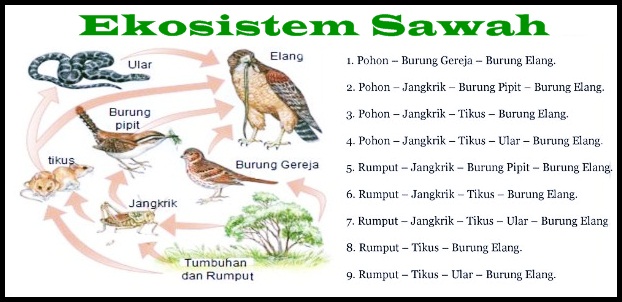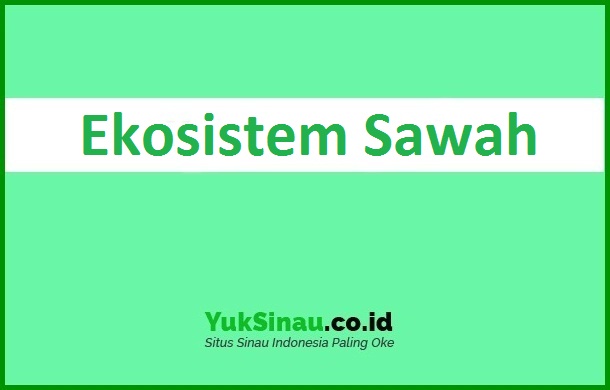Rice Field Ecosystem
The rice field ecosystem is becoming 2 species, namely biotic elements of one of the artificial ecosystems in the area & mainland territory. Rice field ecosystem consists of biotic and abiotic components. For the full explanation, see the Rice Field Ecosystem Material, Definition, Features, Component, Food chain, Example, and Image below.
Table of Contents
Understanding Rice Field Ecosystem

The rice field ecosystem is one of the artificial ecosystems in the region & mainland territory. Rice field ecosystem consists of biotic and abiotic components.
Rice fields are agricultural land that physically has a flat surface, limited by bunds, and can be planted with rice, palawija and other cultivated plants.
Characteristics of Rice Field Ecosystem
As at the beginning, the rice field ecosystem consists of two components, namely:, biotic and abiotic components, both of which are the main characteristics of this rice field ecosystem. The following are some of the characteristics of the ecosystem in rice fields, Among them are:
- Ecosystems are on land with a flat surface and are usually located in highlands.
- The existence of living things that adapt to the highlands or mountains.
- The area is muddy and always flooded with water.
- Usually it will be overgrown with rice plants, which can then be harvested depending on the season.
- Occurs / existence of a food chain.
Rice Field Ecosystem Food Chain
The following are some examples of food chains that occur in rice fields:, as follows :

- Sunlight ~> Rice plant ~> Mouse ~> They are ~> Eagle ~> Decomposition.
- Sunlight ~> Rice plant ~> sparrow ~> They are ~> Eagle ~> Decomposition.
- Sunlight ~> Rice plant ~> Grasshopper ~> Frog ~> They are ~> Eagle ~> Decomposition.
Rice Field Ecosystem Components
The elements of the ecosystem in this rice field area are divided into: 2 type, namely biotic elements / living organisms and abiotic elements / dead things). Here is the full explanation:
Biotic Components
In the rice fields there are types of biotic components like plants and animals. The animals in this field are animals such as insects, rat, bird, velvet, snakes and many more.
The existence of these living things appears naturally. Humans make rice fields with the aim of planting rice only, but the emergence of these biotic components can not be avoided. The biotic components found in rice fields are divided into: 3 that is :
1. Producer
Producers are organisms that can produce or make their own food, like a rice plant & other plants. In paddy fields, rice and other plants become producers that can make their own food by photosynthesis.
2. Consumer
Consumers are organisms that need producers as their food. So, These organisms cannot make their own food so they depend on producers.
Usually, animals that eat plants and eat grains or in the food chain are called Primary Consumers. Some examples are like mice, insect, Sparrow, and others.
There are not only herbivores & omnivore only, because there are also carnivorous animals (carnivore). In the food chain, they are called secondary consumers. For example a frog, Eagle, snakes and others.
3. Decomposer
Decomposition is an organism that decomposes various kinds of remains of living organisms that have died, until it becomes an organic substance. These organic substances are useful for soil fertility, so that soil nutrients become better and plant productivity will increase. Examples are worms, bacteria and fungi.
Abiotic Components
Here are some abiotic components what's in the fields, namely as follows :
1. Land
Soil is formed from weathering of rocks caused by climate, moss plant, and others.
Fertile soil is needed by living organisms, especially plants, fertile soil can make plants grow and develop well.
2. Air
In rice fields water has a very important role to dissolve and carry food sources for rice plants. The availability of water depends on the rainfall, where this rainfall also depends on the climate in that place.
Water is made up of H . molecules2THE, water is usually liquid, because some are solid and gas. Water is a solid such as ice or snow and water is a gas in the form of steam.
other than that, Water is one of the things that living things need for their survival, because the body of living organisms contains water.
3. Sunlight
Sunlight has a very important role for living things, especially for plants in carrying out the process of photosynthesis.
Sunlight also affects the diversity of ecosystem types, because it can determine the temperature in various regions or regions on earth.
4. Air
Air contains various gases such as oxygen (THE), nitrogen (N), carbon dioxide (CO2) , and others.
The function of this oxygen is to breathe, nitrogen works to form proteins, while carbon dioxide is useful for plants in the process of photosynthesis.
5. Climate
Climate is weather conditions over a long period of time, for example per year or per period. While the weather is the climate in an area in a short period of time such as weekly & monthly.
1. Sunlight ~> Rice plant ~> Mouse ~> They are ~> Eagle ~> Decomposition.
2. Sunlight ~> Rice plant ~> sparrow ~> They are ~> Eagle ~> Decomposition.
3. Sunlight ~> Rice plant ~> Grasshopper ~> Frog ~> They are ~> Eagle ~> Decomposition.
The rice field ecosystem is one of the artificial ecosystems in the region & mainland territory. Rice field ecosystem consists of biotic and abiotic components.
Biotic Components
In the rice fields there are various types of biotic components such as plants and animals. The animals in this field are animals such as insects, rat, bird, velvet, snakes and many more.
The existence of these living things appears naturally. Humans make rice fields with the aim of planting rice only, but the emergence of these biotic components can not be avoided. The biotic components found in rice fields are divided into: 3 that is :
1. Producer
Producers are organisms that can produce or make their own food, like a rice plant & other plants. In paddy fields, rice and other plants become producers that can make their own food by photosynthesis.
2. Consumer
Consumers are organisms that need producers as their food. So, These organisms cannot make their own food so they depend on producers.
Usually, animals that eat plants and eat grains or in the food chain are called Primary Consumers. Some examples are like mice, insect, Sparrow, and others.
There are not only herbivores & omnivore only, because there are also carnivorous animals (carnivore). In the food chain, they are called secondary consumers. For example a frog, Eagle, snakes and others.
3. Decomposer
Decomposition is an organism that decomposes various kinds of remains of living organisms that have died, until it becomes an organic substance. These organic substances are useful for soil fertility, so that soil nutrients become better and plant productivity will increase. Examples are worms, bacteria and fungi.
Abiotic Components
1. Land
Soil is formed from weathering of rocks caused by climate, moss plant, and others.
Fertile soil is needed by living organisms, especially plants, fertile soil can make plants grow and develop well.
2. Air
In rice fields water has a very important role to dissolve and carry food sources for rice plants. The availability of water depends on the rainfall, where this rainfall also depends on the climate in that place.
Water is made up of H . molecules2THE, water is usually liquid, because some are solid and gas. Water is a solid such as ice or snow and water is a gas in the form of steam.
other than that, Water is one of the things that living things need for their survival, because the body of living organisms contains water.
3. Sunlight
Sunlight has a very important role for living things, especially for plants in carrying out the process of photosynthesis.
Sunlight also affects the diversity of ecosystem types, because it can determine the temperature in various regions or regions on earth.
4. Air
Air contains various gases such as oxygen (THE), nitrogen (N), carbon dioxide (CO2) , and others.
The function of this oxygen is to breathe, nitrogen works to form proteins, while carbon dioxide is useful for plants in the process of photosynthesis.
5. Climate
Climate is weather conditions over a long period of time, for example per year or per period. While the weather is the climate in an area in a short period of time such as weekly & monthly.
That's our explanation of the Paper Material Rice Field Ecosystem, Thank you for visiting, I hope this article is useful for friends Yuksinau.co.id.
The post Ekosistem Sawah appeared first on YukSinau.co.id.
